Dive into the wild with me as we explore “capybara vs nutria” – comparing habitat, diet, and lifestyles of these intriguing rodent giants!
Key Takeaways:
- Capybaras and nutria are both large rodents with different taxonomic classifications.
- Capybaras are part of the Caviidae family, while nutria belong to the Echimyidae family.
- Capybaras are larger than nutria and do not have a tail, while nutria have long tails.
- Capybaras are more selective in their diet and produce one litter annually, while nutria can produce three.
- Capybaras primarily inhabit forested areas close to water sources, while nutria are found in freshwater wetlands and urban areas.
- Both capybaras and nutria are herbivores and live in social colonies.
- Capybaras are mainly active before dusk and dawn, while nutria are active around sunset and midnight.
- Capybaras are hunted by predators such as jaguars and anacondas, while nutria have more predators in the wild, including alligators and eagles.
- Capybaras have the potential to become invasive species in certain areas, such as Florida.
The Animal Kingdom Compendium: Capybara and Nutria Overview
In the vast realm of the animal kingdom, capybaras and nutria are two fascinating semi-aquatic rodents that have captivated the curiosity of many nature enthusiasts. These unique creatures belong to different taxonomic families, but they share some intriguing traits and characteristics.
Capybaras, scientifically known as Hydrochoerus hydrochaeris, are the largest rodents in the world. They hail from the Caviidae family and are native to South America. Unlike their smaller counterparts, capybaras do not possess a tail. With their webbed feet and sturdy physique, they are perfectly adapted for a semi-aquatic lifestyle.
Nutria, also referred to as Myocastor coypus, belong to the Echimyidae family. Although smaller in size compared to capybaras, they are still impressive creatures. Nutria are characterized by their long tails, which they use for swimming and balance. Originally native to South America, nutria have been introduced to other parts of the world due to fur farming.
| Capybara | Nutria |
|---|---|
| Part of the Caviidae family | Part of the Echimyidae family |
| Largest rodents in the world | Smaller in size compared to capybaras |
| Webbed feet | Long tail for swimming and balance |
| Native to South America | Originally native to South America, introduced to other regions |
Both capybaras and nutria are herbivorous, feeding on a variety of plants and vegetation. They are also highly social animals, living in colonies and displaying complex social dynamics. These unique characteristics make them fascinating subjects for study and observation.
As we delve deeper into the world of capybaras and nutria in the upcoming sections, we will uncover more captivating facts about their behavior, habitat preferences, diet, and many other intriguing aspects that set them apart in the animal kingdom.

One of the key factors that distinguish capybaras and nutria lies in their habitat and distribution, shedding light on their unique ecological roles in different parts of the world. Capybaras are primarily native to South America, where they can be found in various countries such as Brazil, Venezuela, and Colombia. They thrive in forested areas close to water sources such as rivers, lakes, and marshes. Capybaras are semi-aquatic creatures, often spotted submerged in water or basking in the sun on the riverbanks.
Nutria, on the other hand, have a more diverse habitat and distribution. While they are also native to South America, specifically in countries like Argentina, Uruguay, and Paraguay, nutria have been introduced to different parts of the world, including North America, Europe, and Asia. They adapt well to various environments and can be found in freshwater wetlands, swamps, and even urban areas. Nutria are highly adaptable, which has contributed to their spread beyond their native regions.
To better illustrate the distinct differences in habitat and distribution between capybaras and nutria, let’s take a look at the table below:
| Species | Habitat | Distribution |
|---|---|---|
| Capybara | Forested areas near water sources | Primarily South America |
| Nutria | Freshwater wetlands, swamps, urban areas | South America, introduced to other continents |
As we can see, capybaras and nutria have distinct habitat preferences and distribution patterns. Capybaras thrive in forested areas close to water, while nutria are more adaptable and can be found in various habitats, including urban areas. These differences in habitat and distribution contribute to the unique ecological roles these rodent giants play in different parts of the world.

As herbivores, the dietary preferences and feeding habits of capybaras and nutria play a significant role in shaping their behavior and distinguishing them as remarkable rodents in the animal kingdom. While both species rely on vegetation for sustenance, there are distinct differences in what they consume and how they graze.
Capybaras, being the largest rodents in the world, have a more selective diet compared to nutria. They primarily graze on grasses, aquatic plants, and reeds, but they also indulge in fruits and tree barks when available. With their sharp incisors and powerful jaws, capybaras have evolved to efficiently process these fibrous materials, making them true experts in foraging. In fact, their grazing habits have earned them the playful nickname “guinea pigs of the meadow.”
“Capybaras are known for their ability to graze in harmony with their surroundings, shaping ecosystems through their selective diets.”
In contrast, nutria are less selective and more opportunistic in their feeding habits. They have a broader range of food sources, including roots, tubers, and leaves from various plants. Nutria’s adaptability allows them to thrive in different habitats, from wetlands to urban areas. Their voracious appetites and ability to consume large quantities of vegetation have led to concerns about their impact on ecosystems.
| Capybara | Nutria |
|---|---|
| Selective herbivores | Less selective herbivores |
| Primarily graze on grasses, aquatic plants, and reeds | Consume roots, tubers, leaves, and a wide variety of plants |
| Indulge in fruits and tree barks when available |
These dietary distinctions not only contribute to the uniqueness of capybaras and nutria but also play a crucial role in shaping their respective ecosystems. By understanding their feeding habits, we gain insights into their behavior, adaptability, and the important ecological roles they fulfill.

Capybaras and nutria are not just ordinary rodents but rather highly social animals that exhibit fascinating group dynamics, making them intriguing subjects of study and often sought-after pets. Capybaras, known as the largest rodents native to South America, are social animals that live in large groups near bodies of water. They form tight-knit communities, known as colonies, consisting of multiple adults and their offspring. These social gatherings provide them with protection against predators and facilitate mutual grooming, which helps establish and strengthen social bonds. Nutria, also native to South America, exhibit similar social behavior, often living in small groups called coypus. These groups typically consist of an adult female nutria, her offspring, and occasionally a few adult males. Living near bodies of water, nutria colonies can be found in freshwater wetlands as well as urban areas.
Capybaras and nutria have some differences in their behavior and habitat preferences. Capybaras primarily live in forested areas close to water sources, such as rivers, lakes, and swamps. They are mostly active before dusk and dawn, known as crepuscular activity. Nutria, on the other hand, are primarily active around sunset and midnight. They are excellent swimmers, equipped with webbed feet that allow them to navigate through wetland habitats. Despite their slight behavioral variations, both capybaras and nutria share a strong social instinct, often establishing close bonds within their groups.
These remarkable social behaviors of capybaras and nutria have attracted the attention of researchers and animal enthusiasts alike, contributing to their popularity as pets. Many people are captivated by their unique social dynamics and enjoy observing their interactions within a group setting. The social nature of these creatures is evident in their playful behavior, as they engage in activities such as grooming each other, vocalizing, and even sleeping in piles to maintain social bonds. These interactions provide insights into their complex social hierarchies and cooperative behaviors, highlighting their remarkable intelligence and adaptability.
In conclusion, capybaras and nutria exemplify the characteristics of highly social animals, captivating researchers and pet owners alike. Their intriguing group dynamics, playful behavior, and close bonds within their colonies make them fascinating subjects of study and cherished companions. Whether living in the wild or as pets near bodies of water, these rodent giants continue to display their innate social instincts and contribute to the diversity of the animal kingdom.
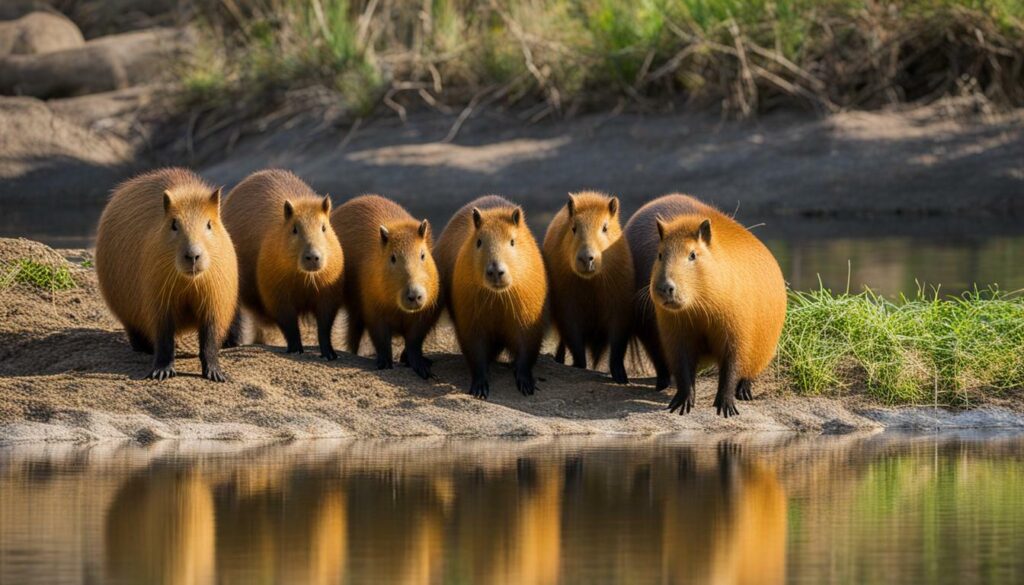
| Characteristics | Capybaras | Nutria |
|---|---|---|
| Family Classification | Caviidae | Echimyidae |
| Size | Larger | Smaller |
| Tail | Absent | Present |
| Diet | Selective | Less selective |
| Reproduction | One litter per year | Up to three litters per year |
| Habitat | Forested areas close to water sources | Freshwater wetlands and urban areas |
Size and Physical Characteristics
When it comes to size and physical characteristics, capybaras and nutria are in a league of their own, leaving us in awe of their impressive dimensions and fascinating adaptations. Capybaras, known as the largest rodents in the world, can reach an astounding length of up to 4 feet and weigh around 150 pounds. Their massive bodies are supported by short, stocky legs and webbed feet, perfectly designed for their semi-aquatic lifestyle. In contrast, nutria are smaller, measuring around 2 to 3 feet in length and weighing between 15 to 20 pounds. They also possess webbed feet, allowing them to maneuver effortlessly through their aquatic habitats.
These two animals may share some similarities, such as their webbed feet, but their size is a key characteristic that sets them apart. Capybaras are truly the giants of the rodent world, while nutria exhibit a smaller, more compact stature. However, both animals possess incredible adaptations that enable them to thrive in their respective environments.
“What’s the difference?” you may ask. Well, capybaras are the clear winners in terms of sheer size and weight. They hold the title for being the largest rodents on the planet, captivating us with their imposing presence. Nutria, on the other hand, may not reach the same impressive dimensions as their capybara counterparts, but they still hold their own in the rodent realm.
| Capybara | Nutria |
|---|---|
| Length: Up to 4 feet | Length: 2 to 3 feet |
| Weight: Around 150 pounds | Weight: 15 to 20 pounds |
| Physical Traits: Short, stocky legs and webbed feet | Physical Traits: Compact body size and webbed feet |
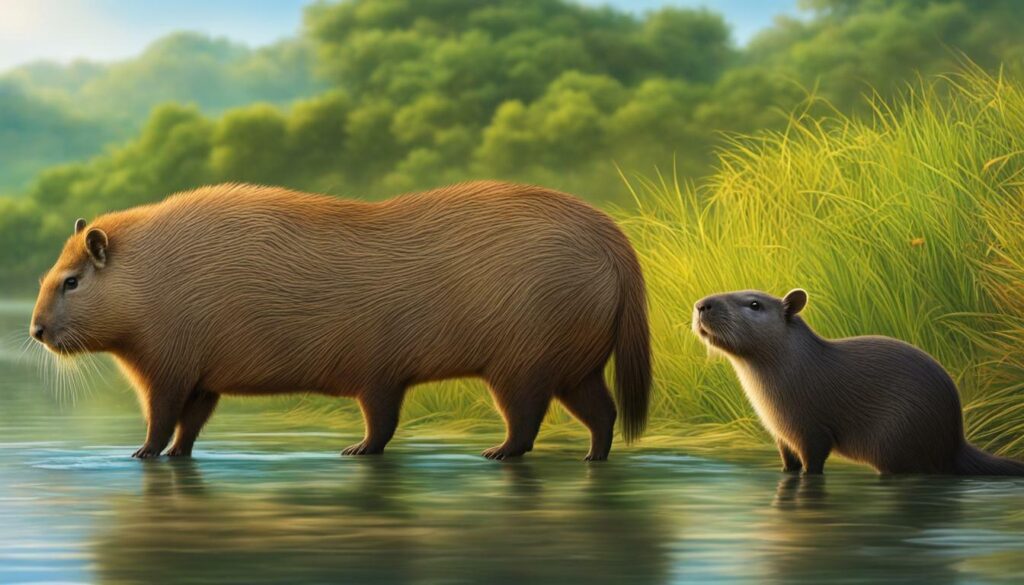 When observing capybaras and nutria side by side, it’s hard not to be captivated by their size and physical attributes. Whether it’s the towering presence of the capybara or the compact yet nimble frame of the nutria, these rodents never fail to catch our attention. Their unique adaptations allow them to thrive in their respective habitats, whether it’s the dense forests near water sources for capybaras or the freshwater wetlands for nutria.
When observing capybaras and nutria side by side, it’s hard not to be captivated by their size and physical attributes. Whether it’s the towering presence of the capybara or the compact yet nimble frame of the nutria, these rodents never fail to catch our attention. Their unique adaptations allow them to thrive in their respective habitats, whether it’s the dense forests near water sources for capybaras or the freshwater wetlands for nutria.
In Conclusion
In this section, we’ve explored the size and physical characteristics that distinguish capybaras and nutria. The capybara reigns as the largest rodent, with its massive body and webbed feet perfectly suited for its semi-aquatic lifestyle. Nutria, while smaller in size, exhibit their own unique adaptations that help them navigate their watery habitats. These two animals may differ in size, but they both leave us amazed and fascinated by their remarkable presence.
Reproduction and Life Cycle
The reproductive processes and life cycles of capybaras and nutria offer intriguing insights into their abilities to propagate and adapt, though their impacts on local ecosystems can vary. Female nutria typically have a gestation period of around 130 days before giving birth to a litter of 1 to 13 offspring. On the other hand, capybaras have a slightly longer gestation period of approximately 150 days and usually give birth to between 1 and 8 young. It’s interesting to note that capybaras are known for their strong maternal instincts and often keep their young close, protecting them from potential predators.
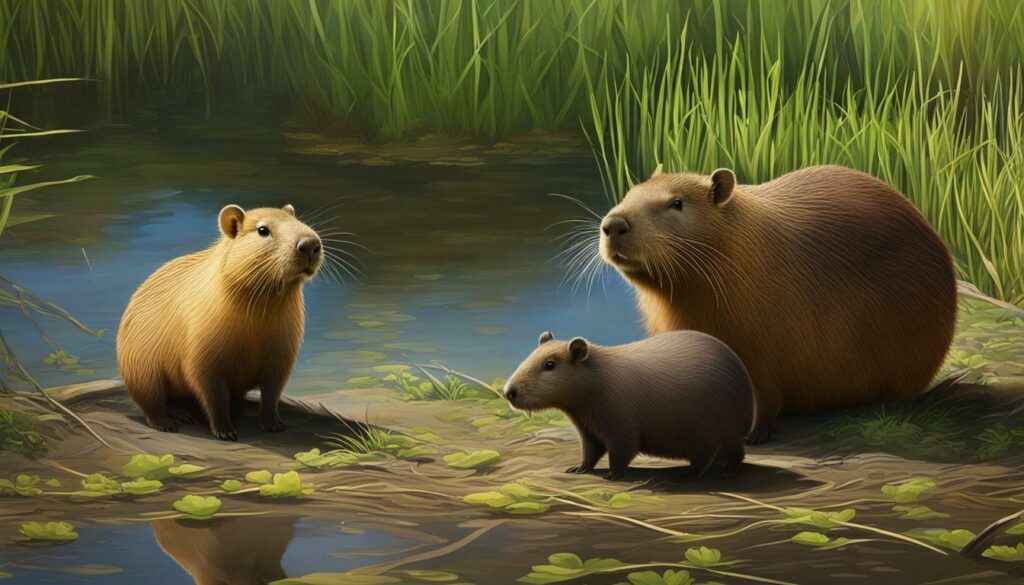
Due to their adaptable nature, nutria populations have been able to thrive and expand in various regions, sometimes to the detriment of local ecosystems. They are considered invasive in several parts of the world, including North America, where their burrowing habits and consumption of aquatic plants can cause damage to wetland habitats. On the other hand, capybaras are primarily found in South America and have not established invasive populations in other continents. However, there is ongoing concern about their potential impact if they were to become invasive, particularly in regions like Florida where loose populations are already present.
| Species | Gestation Period | Litter Size | Invasive Status |
|---|---|---|---|
| Capybara | Approximately 150 days | 1-8 offspring | Not considered invasive outside of South America |
| Nutria | Around 130 days | 1-13 offspring | Considered invasive in certain regions |
“The reproductive processes and life cycles of capybaras and nutria offer intriguing insights into their abilities to propagate and adapt, though their impacts on local ecosystems can vary.” – Researcher studying capybaras in Florida
While capybaras are sometimes kept as pets, there is a need for responsible ownership and management to ensure they do not pose a threat to local environments. It’s important to remember that introducing non-native species into new habitats can have unintended consequences. By studying the reproductive behaviors and life cycles of capybaras and nutria, researchers hope to better understand their potential for population growth and the impacts they may have on native ecosystems. This knowledge can help inform conservation efforts and management strategies to maintain a balance between these fascinating rodent giants and the delicate ecosystems they inhabit.
Habitats and Behavior in the Wild
Although belonging to different families, capybaras and nutria share certain traits owing to their status as semi-aquatic rodents native to South America, yet they exhibit distinct differences in their behavior, size, and ecological preferences.
Capybaras, as the largest rodents in the world, are primarily found in forested areas close to water sources such as rivers, lakes, and marshes. They are excellent swimmers and have webbed feet that help them navigate through their semi-aquatic habitat. Capybaras are mostly active during the early morning and evening hours, before dusk and dawn.
Nutria, also native to South America, are smaller than capybaras and are well-adapted to freshwater wetlands. They can also thrive in urban areas with artificial water sources. Nutria are primarily active around sunset and midnight, venturing out of their burrows to forage for food during these times.

| Capybara | Nutria |
|---|---|
| Primarily found in forested areas near water sources | Adapted to freshwater wetlands and urban areas |
| Active before dusk and dawn | Active around sunset and midnight |
| Highly selective in their diet | Less selective and will eat a wide variety of plants |
| Susceptible to predation by jaguars and anacondas | Face threats from alligators and birds of prey, such as eagles |
Capybaras are fascinating creatures that exhibit social behavior, living in large groups called herds or colonies. Their group dynamics involve cooperative behavior, mutual grooming, and even vocalizations to communicate with one another. On the other hand, nutria are solitary animals that occupy their own territories, although they may tolerate the presence of other nutria within their range.
In conclusion, capybaras and nutria, two semi-aquatic rodents, share some similarities due to their South American origins. However, their distinct characteristics, including differences in size, behavior, and habitat preferences, set them apart. Understanding these differences allows us to appreciate the diversity within the rodent kingdom and further explore the mysteries of capybara vs. nutria.
Capybara vs Nutria: Similarities
Despite some distinct characteristics that set capybaras and nutria apart, they also share intriguing similarities, which contribute to their appeal as captivating creatures in the animal kingdom. Both capybaras and nutria are often kept as pets, thanks to their gentle and sociable nature. These semi-aquatic rodents have a wide range of admirers who appreciate their unique qualities and their ability to form bonds with humans.
One of the most notable similarities between capybaras and nutria is their size. While capybaras are much larger, with some individuals reaching up to 4 feet in length and weighing over 100 pounds, nutria are known for their relatively large size among rodents, typically measuring between 1 to 2 feet long. The substantial size of both species contributes to their impressive presence and contributes to their appeal as pets and subjects of fascination.
Another shared characteristic is their herbivorous diet. Both capybaras and nutria primarily feed on vegetation, including grasses, aquatic plants, and fruits. This shared dietary preference aligns with their semi-aquatic lifestyle, as they can often be found near bodies of water where they have ample access to their preferred food sources.
Overall, the similarities between capybaras and nutria make them fascinating creatures to study and appreciate. Whether it’s their size, sociability, or herbivorous diet, these rodent giants offer a glimpse into the diverse world of nature and highlight the unique traits that set them apart from other animal species.
Image
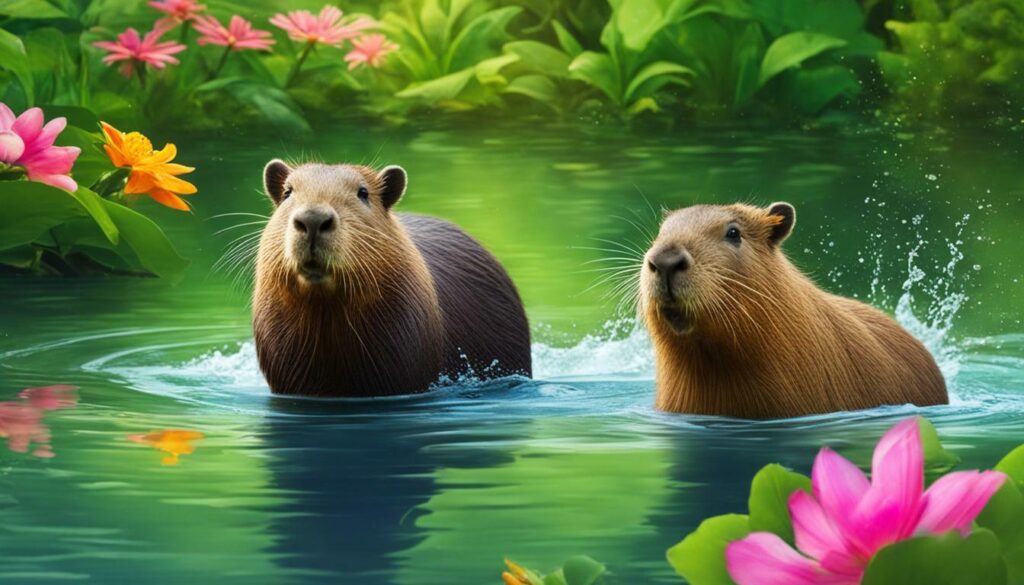
| Capybara | Nutria |
|---|---|
| Often kept as pets | Often kept as pets |
| Primarily found in South America | Primarily found in South America |
| Large size (up to 4 feet long) | Relatively large size (1 to 2 feet long) |
| Semi-aquatic rodents | Semi-aquatic rodents |
| Herbivorous diet | Herbivorous diet |
| Social creatures | Social creatures |
Capybara vs Nutria: Differences in Size
One of the most noticeable distinctions between capybaras and nutria lies in their size, with each species possessing distinct physical characteristics that contribute to their remarkable stature. Capybaras are the largest rodents in the world, measuring around 4 feet in length and weighing up to 150 pounds. These gentle giants have a robust and barrel-shaped body, short legs, and webbed feet that make them excellent swimmers. On the other hand, nutria are smaller in comparison, typically measuring between 2 and 3 feet in length and weighing around 20 to 25 pounds. They have a slender body, a long, round tail, and partially webbed hind feet, which assist them in navigating their semi-aquatic habitat.
| Capybara | Nutria | |
|---|---|---|
| Size | Largest rodent, up to 4 feet | Smaller rodent, 2 to 3 feet |
| Weight | Up to 150 pounds | Around 20 to 25 pounds |
| Body Shape | Robust and barrel-shaped | Slender |
| Tail | No tail | Long and round |
| Feet | Webbed feet | Partially webbed hind feet |
Did you know? Capybaras are the size of a small pig, while nutria are closer in size to a large house cat.
These physical differences between capybaras and nutria not only affect their appearance but also their behavior and habitat preferences. Capybaras’ larger size enables them to navigate through dense vegetation and swim in bodies of water with ease. This is why they primarily live in forested areas close to water sources, such as rivers, lakes, and marshes. Nutria, with their smaller size and agility, are well-adapted to freshwater wetlands and can also thrive in urban areas, including drainage ditches and park ponds.
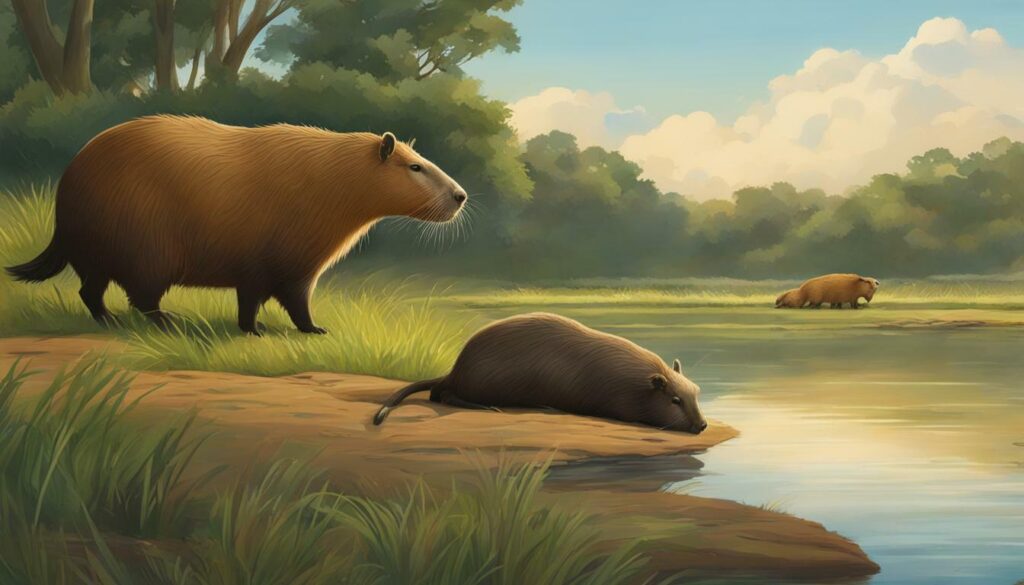
In conclusion, the disparities in size and physical characteristics between capybaras and nutria contribute to their distinct appearances and habitats. Capybaras’ larger size and webbed feet make them well-suited for their semi-aquatic lifestyle, while nutria’s smaller size and partially webbed hind feet allow them to maneuver through wetland environments. Understanding these differences provides us with a greater appreciation for the diversity of rodent species in the animal kingdom.
Capybara vs Nutria: Habitat and Distribution
The habitat and distribution choices of capybaras and nutria play a vital role in shaping their behavior, diet, and ultimately, their lifespan, further highlighting the distinctions between these fascinating rodents. Capybaras primarily inhabit forested areas close to water sources, such as rivers, swamps, and marshes, in South America. They are semi-aquatic creatures, spending much of their time in or near water to regulate body temperature and escape predators. Nutria, on the other hand, can be found in a wider range of habitats, including freshwater wetlands and even urban areas.
Capybaras are most active before dusk and dawn, as they prefer cooler temperatures. During the day, they seek shelter in dense vegetation or muddy areas near water. Nutria, on the other hand, are mainly active during the late evening, around sunset, and at night, around midnight. They are well-adapted to their wetland habitats, using their webbed feet for swimming and their long tails for balance. Nutria are known to establish burrows in riverbanks, marshes, or even abandoned structures near water.
When it comes to diet, capybaras are more selective, primarily grazing on grasses, aquatic vegetation, and fruits. They are considered hindgut fermenters, meaning they have a specialized digestive system that allows them to extract the maximum nutrients from plant material. Nutria, on the other hand, are less selective and have a broader diet. They will consume a wide variety of plants, including grasses, roots, stems, and even crops, which has led to concerns about their impact on agriculture in some regions.
It’s worth noting that capybaras face predation primarily from jaguars and anacondas in their natural habitat. Nutria, on the other hand, have a greater number of predators, including alligators, eagles, and larger predatory birds. These predators play a crucial role in controlling the population of nutria in their respective habitats.
| Capybara | Nutria | |
|---|---|---|
| Preferred Habitat | Forested areas close to water sources like rivers, swamps, and marshes | Freshwater wetlands and urban areas |
| Activity Time | Most active before dusk and dawn | Primarily active during late evening and at night |
| Diet | Selective grazers of grasses, aquatic vegetation, and fruits | Less selective, consuming a wide range of plants |
| Predators | Jaguars and anacondas | Alligators, eagles, and larger predatory birds |
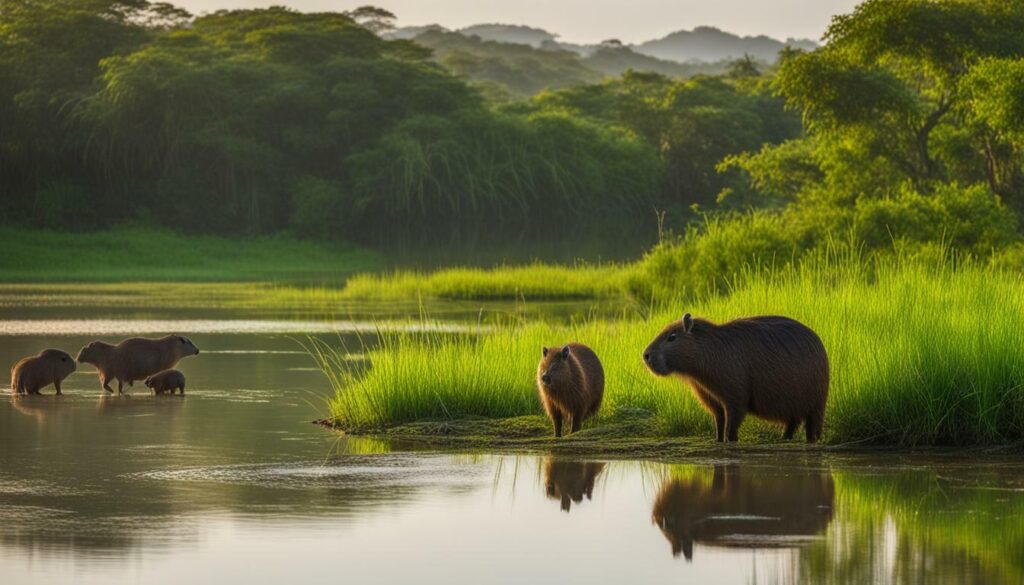
Understanding the habitat preferences and distribution patterns of capybaras and nutria sheds light on the diverse adaptations and behaviors of these remarkable rodents. Their unique lifestyles and interactions with their surroundings contribute to the rich biodiversity of their respective ecosystems.
Capybara vs Nutria: Behavior and Social Interactions
The behavior and social interactions of capybaras and nutria offer a captivating glimpse into the distinct traits and nuanced behavior that make them stand out in the world of rodent giants. Capybaras, being highly sociable animals, live in large groups known as colonies or herds, consisting of up to 100 individuals. These groups are typically led by a dominant male who ensures order and protects the herd from potential threats. Capybaras are known for their gentle and friendly nature, often engaging in mutual grooming and close bonding with their companions.
On the other hand, nutria, also known as coypus, exhibit slightly different social dynamics. While they can live in small family groups, known as colonies, they are generally more solitary creatures compared to capybaras. Nutria establish territories and mark them with gland secretions, maintaining a more independent and self-reliant lifestyle. Although nutria may come across as more reserved, they can still show occasional cooperation and socialization, especially during mating season.
“Capybaras are known for their gentle and friendly nature, often engaging in mutual grooming and close bonding with their companions.”
These behavioral differences can be attributed to the distinct ecological niches that capybaras and nutria occupy. Capybaras primarily inhabit forested regions near water sources, where their social dynamics play a crucial role in keeping the group safe from predators. Nutria, on the other hand, prefer freshwater wetlands, where they can establish their territories and adapt to a more solitary lifestyle.
The contrasting behavior and social interactions of capybaras and nutria underline their remarkable ability to adapt to different environments and thrive in their respective habitats. Understanding these behaviors not only provides valuable insights into their fascinating lives but also helps researchers and conservationists develop effective strategies for their conservation and management.

Nourishment is a fundamental aspect of the lives of capybaras and nutria, and understanding their respective diets and feeding habits unveils their distinctive preferences and adaptations. While these large rodents share similarities as herbivores, their specific food choices and eating behaviors set them apart.
Capybara Diet: Capybaras are selective grazers with a predominantly herbivorous diet. Their diet mainly consists of grasses, aquatic plants, and fruits. They are known to be particular about the quality and freshness of their food, often browsing for tender leaves and young shoots. Capybaras also have specialized digestive systems that allow them to efficiently extract nutrients from fibrous vegetation.
Nutria Diet: Nutria, on the other hand, are highly adaptable and less selective in their feeding habits. They consume a wide variety of plants, including grasses, roots, tubers, and aquatic vegetation. Nutria have even been observed feeding on agricultural crops such as rice and sugarcane, causing concerns in certain regions.
Contrasting Feeding Behaviors: Capybaras and nutria also differ in their feeding behaviors. Capybaras are known to graze and forage in groups, often forming large social gatherings while searching for food. They use their sharp incisors to bite off vegetation at ground level, making them well-suited for grazing. Nutria, on the other hand, are more solitary feeders and will often venture into the water to search for food, using their webbed feet to swim and dive for aquatic plants.
Understanding the diets and feeding habits of capybaras and nutria provides insight into their ecological roles and adaptations. These unique preferences contribute to the diverse ecosystems they inhabit, showcasing the remarkable diversity even within the realm of herbivorous rodents.
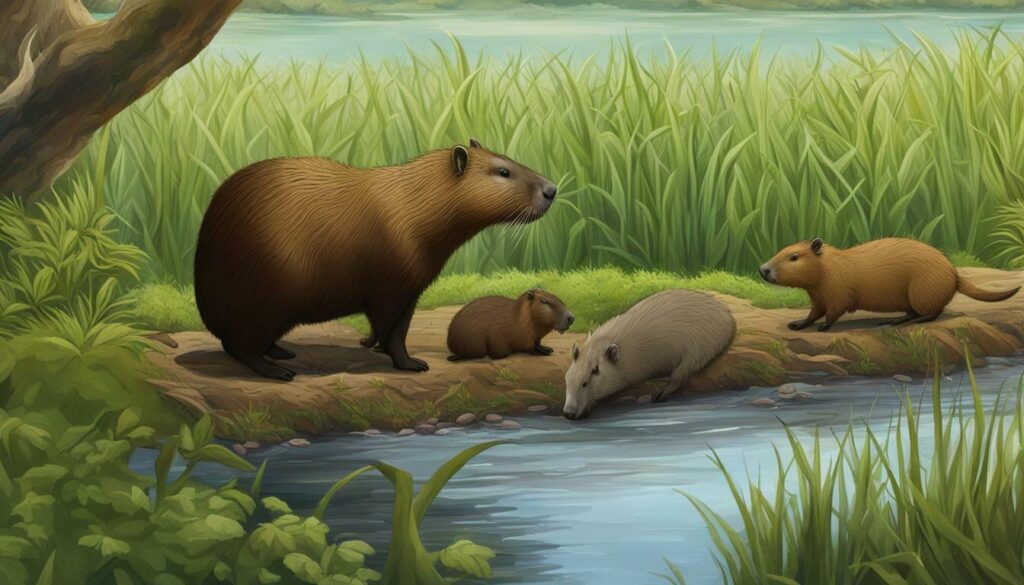
| Capybara | Nutria | |
|---|---|---|
| Primary Food Sources | Grasses, aquatic plants, fruits | Grasses, roots, tubers, aquatic vegetation |
| Feeding Behavior | Grazing in groups, selective browsing | Adaptable solitary feeding, diving for aquatic plants |
| Specialized Adaptations | Efficient digestion of fibrous vegetation | Webbed feet for swimming and diving |
Capybara vs Nutria: Lifespan and Survival
The lifespan and survival strategies adopted by capybaras and nutria offer insights into their resilience and ability to thrive in various ecosystems, further distinguishing them as remarkable rodent giants.
Starting with capybaras, these herbivorous mammals have an average lifespan of 8 to 10 years in the wild. However, in captivity, they can live up to 12 years or more. Capybaras have adapted well to their habitats, which include forested areas near water sources, such as rivers, lakes, and marshes. Their semi-aquatic nature enables them to cool down in the water during hot weather and escape potential predators, such as jaguars and anacondas.
Nutria, on the other hand, have a shorter lifespan compared to capybaras. In the wild, nutria typically live for about 3 to 6 years, but in captivity, their lifespan can extend to around 9 years. These resilient creatures are well-suited to freshwater wetlands and can also thrive in urban areas. Nutria are excellent swimmers with their webbed feet, which allow them to navigate through water and escape predators, including alligators and eagles.
The contrasting lifespans of capybaras and nutria can be attributed to various factors, including their size, diet, and habitat preferences. Capybaras, as the largest rodents in the world, have a relatively longer lifespan, while nutria, being smaller, face different challenges in terms of survival. Both species, however, have demonstrated their adaptability and ability to coexist with other animals in their respective ecosystems.
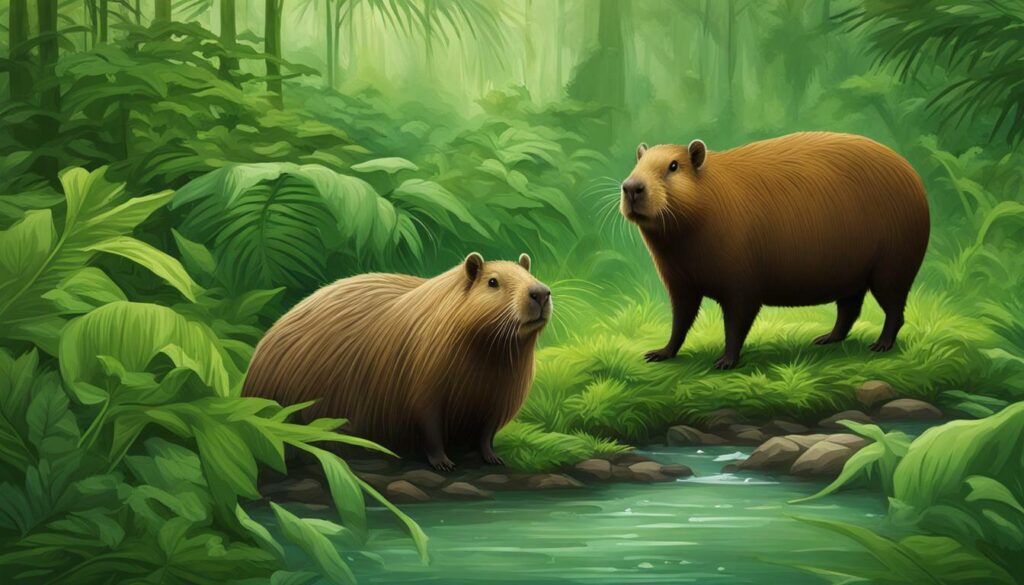
| Species | Wild Lifespan | Captive Lifespan |
|---|---|---|
| Capybara | 8-10 years | 12+ years |
| Nutria | 3-6 years | 9 years |
“The contrasting lifespans of capybaras and nutria can be attributed to various factors, including their size, diet, and habitat preferences.”
Resilience in Challenging Environments
Capybaras and nutria have different approaches to survival in challenging environments. Capybaras, with their larger size and more selective diet, have developed distinct adaptations that allow them to thrive in their natural habitats. Their ability to graze on grasses and aquatic plants ensures a steady food supply even during periods of drought or scarce vegetation.
Nutria, on the other hand, have a more opportunistic feeding behavior and can consume a wide variety of plants and crops. This adaptability enables them to survive in different environments, including wetlands and urban areas where food sources may be more abundant but also more diverse.
Overall, the lifespan and survival strategies of capybaras and nutria highlight their remarkable ability to adapt to diverse ecosystems. These rodent giants continue to fascinate researchers and wildlife enthusiasts alike, offering valuable insights into the resilience and survival tactics of these unique creatures.
Conclusion: Unraveling the Secrets of Capybara vs Nutria
By exploring the facts and comparisons between capybaras and nutria, you’ll emerge with a deeper understanding of these captivating rodent giants and their unique place in the animal kingdom.
Capybaras and nutria, though both large rodents, have different taxonomic classifications. Capybaras belong to the Caviidae family, while nutria are part of the Echimyidae family. Capybaras, known for their impressive size, lack a tail, whereas nutria possess a long, distinguishable tail.
When it comes to diet and reproductive habits, capybaras are more selective, consuming a limited range of plants and producing only one litter annually. In contrast, nutria have a less selective diet and can produce up to three litters per year.
While capybara populations are predominantly found in South America, nutria have been introduced to various continents. Capybaras tend to inhabit forested areas near bodies of water, while nutria thrive in freshwater wetlands and urban environments. These differences in behavior and habitat preferences contribute to the unique survival strategies of each species.
Understanding the distinct characteristics and behaviors of capybaras and nutria is essential for appreciating their role in the ecosystem. Capybaras and nutria’s significance extends beyond their size and appearance, and further research can provide valuable insights into their interactions with other species in their respective habitats.
FAQ
Are capybaras and nutria the same species?
No, capybaras and nutria belong to different taxonomic families. Capybaras are part of the Caviidae family, while nutria are part of the Echimyidae family.
How do capybaras and nutria differ in size?
Capybaras are much larger than nutria. Capybaras can reach up to 4 feet in length and weigh around 150 pounds, while nutria are smaller, typically measuring around 2-3 feet in length and weighing around 20-30 pounds.
What are the habitat preferences of capybaras and nutria?
Capybaras primarily live in forested areas close to water sources, while nutria are found in freshwater wetlands as well as urban areas.
How do capybaras and nutria differ in their feeding habits?
Capybaras are more selective in their diet and graze on a variety of vegetation, while nutria are less selective and will eat a wide variety of plants.
What is the reproduction rate of capybaras and nutria?
Capybaras produce only one litter annually, while nutria can produce up to three litters per year.
Are capybaras and nutria social animals?
Yes, both capybaras and nutria are social creatures that live in colonies.
What are the predators of capybaras and nutria?
Capybaras are hunted by predators such as jaguars and anacondas, while nutria have more predators in the wild, including alligators and eagles.
Are there concerns about capybaras becoming invasive in certain areas?
Yes, there are concerns that capybaras could become invasive in Florida, as there are already around 50 loose in the state. However, more research is needed to determine if they will cause harm to the environment or human health.
What is the research focus of the scientist studying capybaras in Florida?
The researcher studying capybaras in Florida is interested in studying the invasion process and hopes to prevent the spread of capybaras without killing them all.

